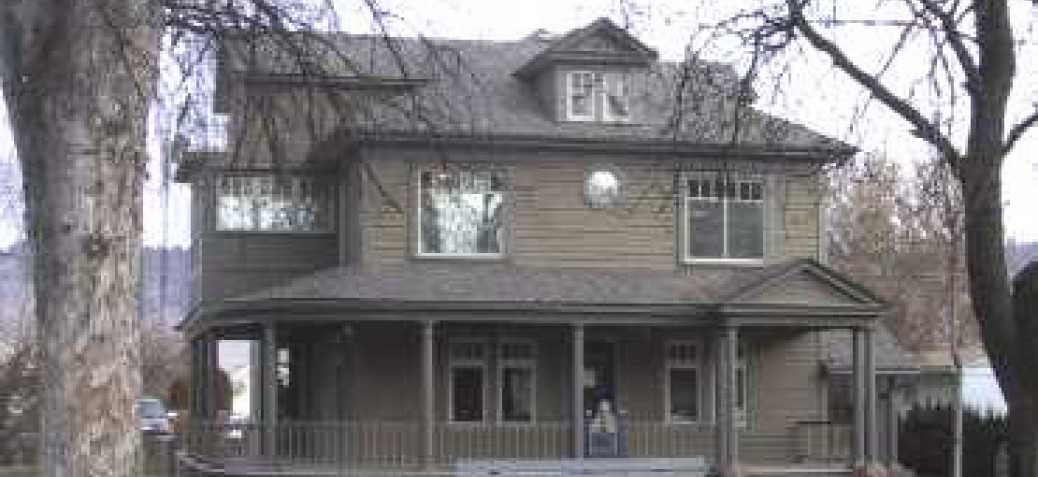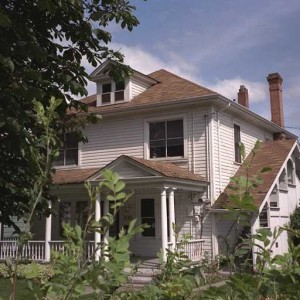J.W. Jones House
Place Description
The historic place is the 2.5-storey, wood-clad J.W. Jones House, built in 1912 and located at 830 Bernard Avenue in Kelowna's historic North Central neighbourhood; and a detached garage.
Heritage Value
The J.W. Jones House has heritage value for its association with a high-profile owner who played a major role in early real estate activities and political affairs, for its fine architectural design, and for representing changes in land use on upper Bernard Avenue.
This fine residence, built in 1912 and larger than those around it, testifies to the success of its first owner, James ('Jimmy') William Jones, an important property developer, businessman, and politician (both municipal and provincial) in early Kelowna.
Jones's profile represents that of many early Kelowna businessmen. Born in Ontario in 1869, he came to Kelowna in 1907 after spending twenty years in Grenfell, Saskatchewan. He went into real estate development in partnership with Dr. W.H. Gaddes, forming a number of significant companies in the land development business, such as the Central Okanagan Land and Orchard Company and the Kelowna Irrigation Company, the latter of which developed property beyond the city center, in Rutland and Glenmore. Jones also bought shares in the McKenzie Grocery and in Thomas Lawson Ltd.
A 'go-getter', Jones soon went into civic politics. He was elected Alderman in 1910 and Mayor in 1912, serving five terms in office. In 1916 he stepped up a political level and ran as the Conservative candidate in the newly redistributed South Okanagan riding. He won, but the Conservative government under Premier W.J. Bowser was defeated, so Jones sat for twelve years on the opposition benches. When the Conservative Party won power in 1928 under S.F. Tolmie, Jones was appointed Speaker. In 1930, as the Great Depression descended on Canada, he became Finance Minister. The measures he introduced to try to stem the tide, including payroll deductions of taxes and a one-percent tax on all incomes over $25, earned him the nickname of 'One Percent Jones.' The Tolmie government disintegrated under the pressures of the Depression; in the 1933 election Jones ran as an independent and was defeated. With his political career ended, Jones moved to Victoria and went into the bond and financial business. He died there in 1954.
Jones built this large house in 1912 when he was at the peak of his local business and political careers; he also had a summer residence on Manhattan Point. The house has value for its attractive architectural design. The hipped-roof 'foursquare' form is elaborated with an open verandah on two sides and an asymmetrical wing at the rear, which, if they are original (as is likely), would be considered to be features of the picturesque Queen Anne style.
The Jones house is representative of changing land uses along upper Bernard Avenue. Like many other large houses in the area, it was divided up in the 1940s, when housing was in short supply (to a large extent because of World War II), the neighbourhood no longer attracted blue-chip residents, and domestic servants became unavailable. It was converted to multiple-residential use in 1942, at which time a staircase was added on one side and additions were made at the rear. It was again adapted, in 2001, to become a law office, reflecting the current demand in the North Central neighbourhood for professional and gallery space.
Character Defining Elements
- Two-storey hipped-roof 'foursquare' house; the square form elaborated with a wrap-around columned verandah (across front and left sides), pedimented at the front entrance; and with a two-storey rear wing
- Ground-floor bay window protruding into porch on left side
- Pedimented dormer facing the street
- Narrow scalloped horizontal wood siding on all elevations
- Octagonal window on second floor facing street
- Numerous mature trees and shrubs, and large lawn all around






